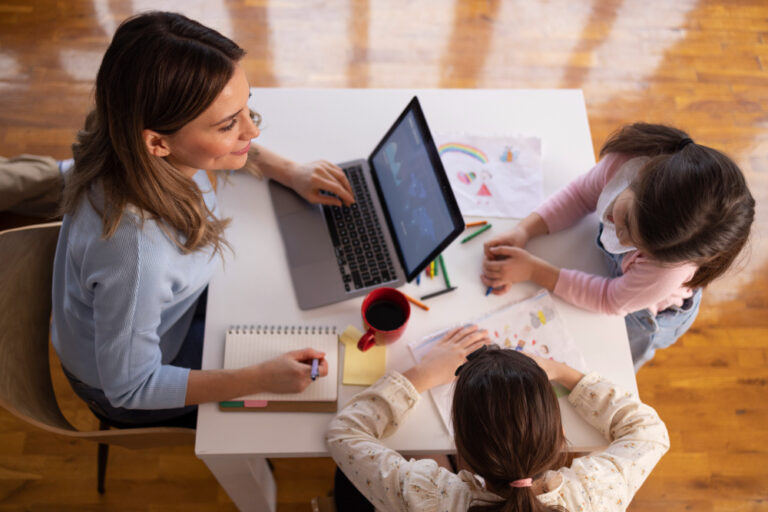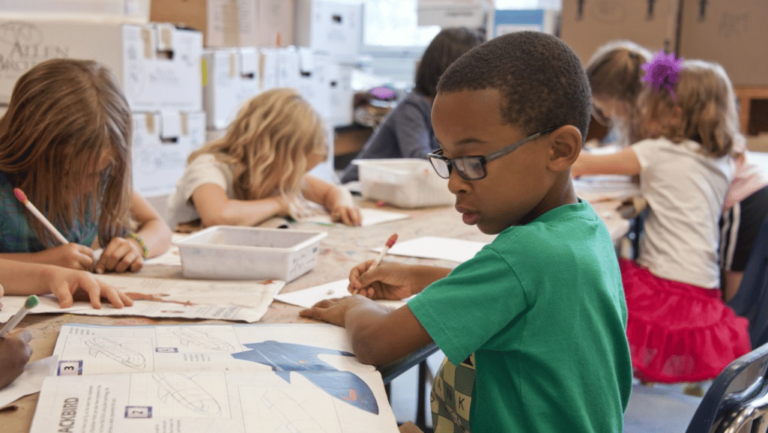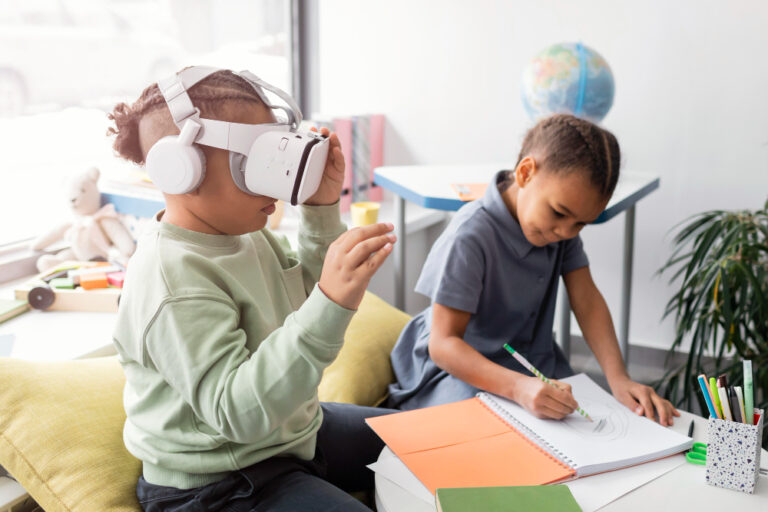As educators, we recognize that each student has a unique way of learning. To create a dynamic and inclusive educational experience, it is essential to incorporate mixed learning style strategies into the classroom. By understanding and addressing individual learning styles, we can engage every student and ensure their success.
In this article, we will explore various blended learning techniques and multimodal learning approaches that can be used to tailor instruction to personalized learning styles. Let’s dive in and discover how to craft the perfect classroom strategy for our diverse group of learners.
Key Takeaways:
- Mixed learning style strategies are crucial for creating an inclusive learning environment.
- Blended learning techniques and multimodal learning approaches cater to individual learning styles.
- Personalized learning styles enable teachers to engage every student effectively.
- By understanding different learning styles, teachers can tailor instruction and enhance student engagement.
- Crafting a student-centered approach through mixed learning styles improves learning outcomes for all students.
Understanding Different Learning Styles
When it comes to effective teaching, recognizing and catering to different learning styles is key. Students have varied approaches to learning, and understanding these styles can greatly enhance classroom instruction. The three main learning styles are auditory, kinesthetic, and visual.
1. Auditory Learners
Auditory learners thrive when information is presented orally. They are most receptive to learning through discussions, lectures, and audio recordings. These learners engage with content by actively listening and processing spoken words.
“I feel most engaged and focused when I can listen to someone explain concepts rather than reading them.” – Emma, 11th-grade student
To accommodate auditory learners, incorporate verbal explanations and encourage class discussions. This allows them to absorb information through listening, promoting better retention and understanding.
2. Kinesthetic Learners
Kinesthetic learners have a preference for hands-on experiences and physical activities. They excel when given the opportunity to engage in practical tasks and manipulate objects. These learners absorb information through movement and tactile experiences.
“I learn best when I can actively participate in activities and experiments, rather than just reading about them.” – Ethan, 8th-grade student
To support kinesthetic learners, incorporate interactive activities, experiments, and simulations into lessons. These hands-on experiences allow them to fully engage with the content and enhance their understanding.
3. Visual Learners
Visual learners rely on visual aids and imagery to understand and retain information. They benefit from seeing diagrams, charts, and other visual representations of concepts. These learners have a strong capacity for visualizing and recalling visual information.
“I find it easier to understand complex topics when there are visual aids or diagrams that illustrate the concepts.” – Olivia, 9th-grade student
To accommodate visual learners, incorporate visual aids, such as charts, graphs, and diagrams, into your teaching materials. These visual representations can help reinforce key concepts and improve comprehension.
Identifying the different learning styles present in your class allows you to tailor your instruction and create a more inclusive and engaging learning environment. By incorporating a variety of teaching methods that cater to auditory, kinesthetic, and visual learners, you can ensure that every student has the opportunity to thrive.
Providing a Variety of Learning Experiences
When it comes to catering to different learning styles, one size does not fit all. To engage students effectively, it is crucial to provide a variety of learning experiences tailored to their individual needs. By incorporating movement, visual aids, and interactive activities into lessons, teachers can create an engaging and dynamic classroom environment. Moreover, using a multisensory approach and offering personalized instruction enables educators to address the diverse needs of their students.
Engaging Lessons through Multisensory Approaches
By incorporating multiple senses into lessons, educators can create a more immersive and interactive learning experience. This multisensory approach allows students to engage with the material in various ways that cater to their learning styles. For example, kinesthetic learners can benefit from hands-on activities or role-playing exercises, while visual learners may excel when presented with visual aids and diagrams. Similarly, auditory learners can engage through class discussions and listening exercises. By diversifying the learning experience, teachers can effectively reach all students, resulting in improved comprehension and retention.
Personalized Instruction for Individual Needs
Personalized instruction involves tailoring teaching methods and content based on individual learning preferences and abilities. By getting to know their students’ strengths, challenges, and interests, teachers can design lessons that resonate with each learner. This approach allows educators to provide targeted support and interventions, fostering a deeper understanding of the subject matter. Furthermore, personalized instruction recognizes and celebrates the unique abilities and learning styles of each student, promoting a positive and inclusive classroom environment.
“When students feel that their unique learning styles and needs are valued and addressed, it not only enhances their engagement but also boosts their confidence and motivation to learn.” – Prof. Emily Johnson, Educational Consultant
To illustrate the importance of catering to learning styles and providing engaging and personalized instruction, consider the example below:
| Learning Style | Engaging Lesson Approach |
|---|---|
| Visual Learners | Integrating visual aids, such as infographics or videos, to reinforce concepts and enable visual learners to process information effectively. |
| Auditory Learners | Including audio recordings or podcasts that present content in an auditory format, allowing auditory learners to engage with the material through listening. |
| Kinesthetic Learners | Providing hands-on activities or experiments that allow kinesthetic learners to actively engage with the subject matter through physical manipulation. |
| Read/Write Learners | Offering written instructions, note-taking activities, and opportunities for creating summaries or written responses to cater to the preferences of read/write learners. |
| Social Learners | Facilitating collaborative projects or group discussions to encourage social learners to interact with peers and benefit from collective knowledge sharing. |
By adopting a variety of approaches like those mentioned above, educators can create engaging lessons that cater to diverse learning styles and interests. These strategies foster a positive learning environment and empower students to reach their full potential.
Strategies for Visual, Auditory, and Kinesthetic Learners
In today’s diverse classrooms, it’s essential for teachers to employ teaching methods that cater to the unique learning preferences of their students. Visual, auditory, and kinesthetic learners each have distinct ways of processing information and engaging with the material. By understanding these learning preferences and implementing effective strategies, educators can create an inclusive and dynamic learning environment for all students.
Visual Learners Mixed Learning Styles
Visual learners rely on visual aids and imagery to understand and retain information. Incorporating charts, diagrams, and infographics into lessons can greatly enhance their learning experience. Visual learners also benefit from color-coding, mind maps, and other visually organized materials that help them make connections and visualize concepts.
To further support visual learners, teachers can:
- Use videos and animations to present complex ideas
- Display relevant images and graphics on slides or whiteboards
- Encourage visual note-taking, sketching, and drawing during lectures
Auditory Learners
Auditory learners absorb information best through listening and verbal explanations. They thrive in discussion-based learning environments and benefit from hearing concepts explained aloud. Incorporating audio recordings, podcasts, or guided discussions can help engage and support auditory learners in the classroom.
To further support auditory learners, teachers can:
- Provide verbal instructions and explanations
- Encourage discussions and debates
- Use podcasts, audiobooks, or online lectures as supplementary resources
Kinesthetic Learners
Kinesthetic learners learn best through hands-on experiences and physical movement. They excel in environments that allow them to actively engage with the material. Incorporating interactive activities, experiments, and simulations into lessons can greatly enhance the learning experience for kinesthetic learners.
To further support kinesthetic learners, teachers can:
- Include hands-on experiments and demonstrations
- Encourage movement and physical involvement during learning activities
- Incorporate manipulatives, such as models or puzzles, to reinforce concepts
By implementing teaching methods that cater to the different learning preferences of visual, auditory, and kinesthetic learners, educators can create a rich and engaging learning environment that supports the needs of every student.
| Learning Style | Preferred Teaching Methods |
|---|---|
| Visual Learners | Use of visual aids, charts, diagrams, and infographics. Encourage visual note-taking and sketching. |
| Auditory Learners | Incorporate verbal explanations, discussions, and podcasts. Provide audio resources as supplementary materials. |
| Kinesthetic Learners | Include hands-on experiences, interactive activities, and physical movement. Utilize manipulatives for reinforcement. |
Accommodating Reading/Writing and Social Learners
When it comes to learning styles, not all students are the same. Some students are reading/writing learners, while others are social learners. As an educator, it is essential to understand these different learning preferences and adapt the classroom environment to accommodate both groups of learners.
Reading/Writing Learners
Reading/writing learners thrive when presented with written materials. They excel at note-taking and summarizing information in their own words. To cater to the needs of reading/writing learners, teachers can provide written instructions, handouts, and textbooks that can be annotated. Encouraging these students to take notes during lectures and discussions can also enhance their learning experience. Additionally, assignments that require reading, writing, and analysis will engage these learners and help them develop their skills.
Social Learners
Social learners, on the other hand, excel in collaborative learning environments. They thrive when given the opportunity to engage in group discussions, work on projects together, and interact with their peers. As an educator, you can accommodate social learners by incorporating collaborative activities into lessons. Group projects, class debates, and interactive learning games are great ways to encourage social learners to actively participate and learn from their peers.
“Collaborative learning allows social learners to thrive by harnessing the power of teamwork and peer interaction.”
Teachers can foster collaborative learning by creating a classroom culture that values teamwork and encourages open communication. By assigning group projects or integrating group work into everyday activities, social learners will feel motivated and engaged in their learning process.
Ultimately, providing a balanced instructional approach that combines written instructions for reading/writing learners and collaborative learning for social learners will create an inclusive learning environment that caters to the diverse needs of all students.
“Incorporating collaborative learning activities into the classroom helps social learners thrive by providing meaningful opportunities for peer interaction and teamwork.”
Conclusion
Crafting a classroom strategy that embraces mixed learning styles is essential for creating an inclusive learning environment. By understanding and addressing the diverse needs of students with different learning styles, teachers can provide a student-centered approach and deliver differentiated instruction.
In an inclusive learning environment, every student feels valued and supported. By embracing mixed learning styles, educators can create a space where all students can thrive and reach their full potential. This approach recognizes that each student has unique strengths and preferences, and it allows for personalized instruction that caters to individual needs.
Differentiated instruction plays a pivotal role in meeting the diverse learning needs of students. By adjusting the content, process, and products of instruction, teachers can ensure that all students are challenged and engaged. This approach not only fosters academic growth but also enhances students’ self-confidence and motivation to learn.
Ultimately, by embracing a student-centered approach and implementing differentiated instruction, educators can create a classroom environment that promotes inclusivity, engagement, and academic success. It is through understanding and celebrating the varied learning styles of students that we can truly provide a comprehensive education that meets the needs of every learner.
Frequently Asked Questions
What are mixed learning style strategies?
Mixed learning style strategies refer to instructional techniques that cater to the diverse learning preferences of students. These strategies incorporate a combination of blended learning techniques, multimodal learning approaches, and personalized learning styles to engage every student and create an inclusive educational experience.
How do I identify different learning styles in my class?
To identify different learning styles in your class, observe how your students engage with different types of activities. Auditory learners prefer listening, kinesthetic learners enjoy hands-on experiences, and visual learners benefit from visual aids. You can also conduct learning style assessments or have students self-assess their preferred learning style.
How can I engage students with different learning styles?
To engage students with different learning styles, provide a variety of learning experiences. This can include incorporating movement, visual aids, and interactive activities into lessons. By using a multisensory approach and offering personalized instruction, teachers can cater to the diverse needs of their students and create meaningful and engaging lessons.
What teaching methods are effective for visual, auditory, and kinesthetic learners?
Visual learners benefit from using visual aids, such as charts and diagrams, while auditory learners thrive in discussions and listening to explanations. Kinesthetic learners learn best through hands-on activities and physical movement. By using teaching methods that cater to these learning preferences, teachers can effectively engage and support visual, auditory, and kinesthetic learners in the classroom.
How can I accommodate reading/writing and social learners?
Reading/writing learners prefer written materials and benefit from note-taking and summarizing information. Social learners thrive in collaborative learning environments and benefit from group discussions and projects. Teachers can accommodate reading/writing and social learners by providing written instructions, encouraging discussions, and creating opportunities for collaborative learning.
















